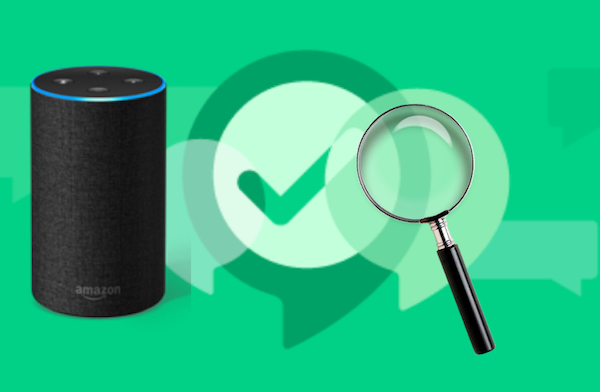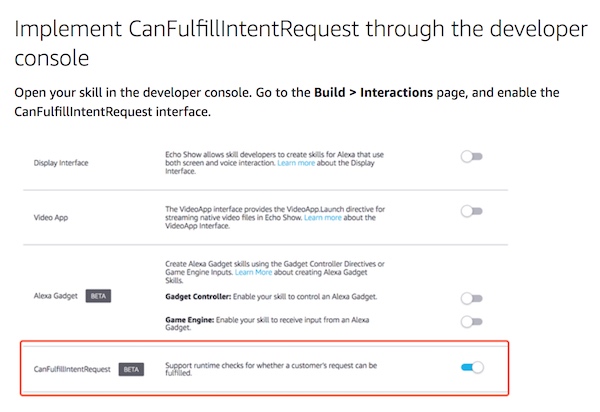Amazon is About to Make Alexa Skill Discovery Much Better for Everyone

Amazon made a quiet announcement yesterday encouraging developers to experiment with a new feature called CanFulfillIntentRequest. This promises to be the most significant update Amazon has made related to Alexa skill discovery since the introduction of the Alexa skill store that enabled online or in-app browsing. The impact of CanFulfillIntentRequest will likely be far greater over time. Sayspring CEO Mark Webster agreed with this assessment in a Tweet about the announcement.
For the last two years, I’ve been talking about how Alexa will connect to third-party apps/Skills based on a user’s question, and the idea of having to remember app/Skill names would fade away. A major step towards that future was just announced today. https://t.co/e1oinNg4El
— Mark C. Webster (@markcwebster) May 30, 2018
Tackling the Challenge of Alexa Skill Discovery
Alexa skill publishers know that the biggest challenge they face today is discovery by users. The rapid growth of Alexa skills to over 30,000 has made it even harder for individual skills to stand out and get noticed by users in the Alexa skill store. CanFulfillIntentRequest is the first time skill publishers will be able to directly influence user discovery on the platform by embedding keyword phrases into their app description that Alexa accesses. Amazon’s Shiraz Datta commented in a blog post yesterday:
“Using CanFulfillIntentRequest, your skill provides information about its ability to fulfill a given customer request at runtime. Alexa combines this information with a machine-learning model to choose the right skill to use when a customer makes a request without an invocation name. As a result, customers find the right skill faster, using the search terms they say most naturally.”
Mr. Datta takes this a step further by offering an example of how Alexa will arbitrate whether a user intent can be fulfilled. A user request will be broken down into the separate abilities off understanding the query and fulfilling the intent. Consider the user request: “Alexa, where is the best surfing today near Santa Barbara?” Mr. Datta explains:
“Alexa can use CanFulfillIntentRequest to ask surfing skills whether they can understand and fulfill the request. A surfing skill with a database of California beaches might be able to both understand and fulfill the request, while one with a database of Hawaiian beaches might only be able to understand it. Based on these responses, Alexa would invoke the skill with the database of California beaches for the customer. Note that Alexa will only send CanFulfillIntentRequest to skills that are likely to be able to handle the associated intent.”
XAPPmedia CEO Pat Higbie pointed out that this will help skill publishers with discovery while also making Alexa appear smarter and more useful to users.
CanFulfillIntentRequest is a mechanism by which 3rd party skills will make Alexa smarter and broaden the range of questions she can answer for consumers. For media outlets and marketers, it is the beginning of Voice SEO for Alexa skills and will dramatically improve discovery of brands by curious consumers who are looking for answers.
Better Matching Users with Alexa Skills
What this will do is help Alexa better match user requests with third-party Alexa skills that can answer them. In September 2017, Voicebot was the first to discover that Alexa was starting to make recommendations. There is a video demonstration of Alexa recommendations accompanying the analysis.
My conclusion at the time was that Alexa was learning and trying match requests, but wasn’t very good at it. Part of the problem was that Alexa had too few signals from the third-party skills to fully understand the types of questions they could answer. The primary signal appeared to be the skill invocation name and description. CanFulfillIntent Request is designed to provide Alexa with more information to determine what existing skills can meet a user intent. A new route to skill discovery by users will be Alexa suggesting options for them to consider.
This is not only good for Alexa skill publishers, but also benefits users. The Alexa skill store bloat has made searching for interesting skills that much harder. Besides, the Alexa skill store was always slightly incongruent with the smart speaker user experience. It offers a visual interface on a different device to support what is supposed to be a voice-driven, hands free, eyes free interaction model. Alexa suggestions using CanFulfillIntentRequest signals can bring skill discovery into the voice user interface for the first time.
Closing the Gap with Google Assistant
Google Assistant trailed Alexa to market by two years, but in this regard has been well out ahead. Google Assistant provides a developer feature called Implicit Invocation, originally referred to as implicit discovery. The description in Actions on Google says:
“Implicit invocation occurs when users invoke your Action without using its name. The Google Assistant attempts to match the user’s request to a suitable Action and then presents a few of these matched Actions to the user based on some qualitative and quantitative signals.”
This is very similar to Mr. Datta’s description of CanFulfillIntentRequest and it is clear that the objective is the same. Google Assistant Action publishers can see the results of Implicit Invocation referral recommendations and user acceptances in the Actions on Google Console. It shows the “matched spoken phrase,” “impressions” and “selections.” The “matched phrase” is what was said by the user while “impressions” represent the number of times Google Assistant suggested the Google Action to the user for that phrase. “Selections” represents the number of times users went on to accept that suggestion and start interacting with the Google Action.
Amazon has made no mention yet as to how developers will be able to track the amount of traffic that is generated by Alexa referrals. The capability to start offering keyword signals for Alexa discovery is an important step. Eventually, developers will also need to know if their CanFulfillIntentRequest efforts are yielding any benefit. An Amazon spokesperson did respond to a Voicebot email query on this topic and offer the following guidance to developers interested in seeing more data related to CanFulfillIntentRequest in production:
“We’re going to be collecting feedback and iterating on the feature throughout the public beta period and are working on ways to make it easier for developers to view metrics related to CanFulfillIntentRequest. We encourage developers to provide their feedback by creating a post and tagging the post with CanFulfillintentRequest on the Alexa Skills Kit developer forum.”
Getting Started with CanFulfillIntentRequest
CanFulfillIntentRequest is officially in beta release and can be accessed by Alexa skill developers using either ASK CLI or through the developer console. Documentation on how to get started can be found here.

I recommend Alexa skill publishers begin using this right away and start down the road of Alexa search engine optimization (voice SEO). When you do, reach out to me on Twitter or LinkedIn to let me know what you have learned and how it impacted your user acquisition and session counts. I will even test your skill if you send me your listed intents to see if Alexa is delivering the goods for you.
Amazon Alexa Has Opinions. Will Make Recommendations. What it Means.
Amazon Alexa Skill Discovery Now Offering Autosuggestions in Search








